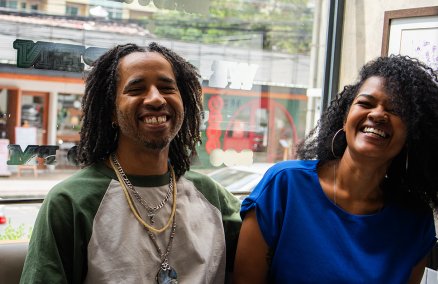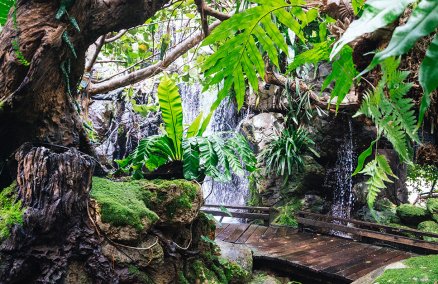Please describe the artworks taken down by the military.
There are five pieces that the military asked us to take down. They include three photographs, a sketch and a seven-page note made by Harit Srikhao about the political movement of 2010. One photo shows training corps students holding guns, half having fun and half ready to shoot. The second features a shirtless reserve officer sitting and waiting for the procession of a VIP person, which Harit has overlaid with collage. The last photo shows an orderly group of women in white, formal public servant uniforms wearing masks of the iconic head statue [by Indian artist Ravindra Reddy and burned down during the CentralWorld fire]. The officers also asked us to take down a sketch by Harit that shows the functions of Sanamluang. Half of the picture shows an important Thai ceremony and the other half is about the political protest. The seven-page note featured Harit’s views on the political situation in 2010.
Why do you think soldiers took offense to these works?
Firstly, the soldier said that he’s worried these works could be threatening to the peace and security of the nation. Then, he asked us to consider our gallery’s safety since someone from the opposite political camp might not be pleased with this and want to harm the gallery. Then he kept coming back to the idea that he’s real serious about assuring the security of this country.
Tell us exactly what happened that day.
I got a text from Angkrit, the owner of Artist+RUN, telling me the military was coming and asking about the operating hours of my gallery and the Cartel Artspace. It was around 9:30am when 10 military guys with 10 plainclothes officers came and asked Angkrit about us. Angkrit told them that both Gallery Ver and Cartel Art Space open in the afternoon, so the soldiers together with plainclothes officers came back later that day. They walked around my gallery and asked us to take the five pieces down. They asked us nicely. My staff took those pieces down. I wasn’t there when this happen. I arrived later and the officers asked me to have a talk with them about this exhibition. I had to admit that I was shocked when I saw them, so before anything else, I dialed my friend for advice, who told me that in order to avoid trouble, I just needed to cooperate and only give short answers to their questions—and only speak when asked.
Did you fear for your personal safety? How did you react?
I was afraid at first because I didn’t know what was happening exactly. But after getting the advice from my old friend and having a conversation with the officers, I was no longer afraid. There was no sign of physical violence. It has had no impact on how I live my life since then. I go wherever I want to. The officers only care about Whitewash. They surveil the exhibition every day now but they don’t follow me.
Has this incident made you more afraid than before of hosting controversial exhibitions?
Not at all. Gallery Ver is a contemporary gallery, which means that we talk about the here and now. We support artists to be themselves and display their work how they want. I don’t want to set any kind of censorship up in my gallery. Gallery Ver still welcomes any political controversial art exhibition. And right now, the thing that people are mostly talking about in this country is politics.
What wider impact do you think this has on creative thinking in Thailand?
I view this as an attempt to use fear to govern this country. Of course when they came into my gallery, they did no harm to us and they spoke to us nicely. However, by act by the military implicitly forces us, both artists and art advocators, to set up a form of self-censorship.
This article was ammended to say that the name of Harit Srikhao's exhibition is Whitewash.















